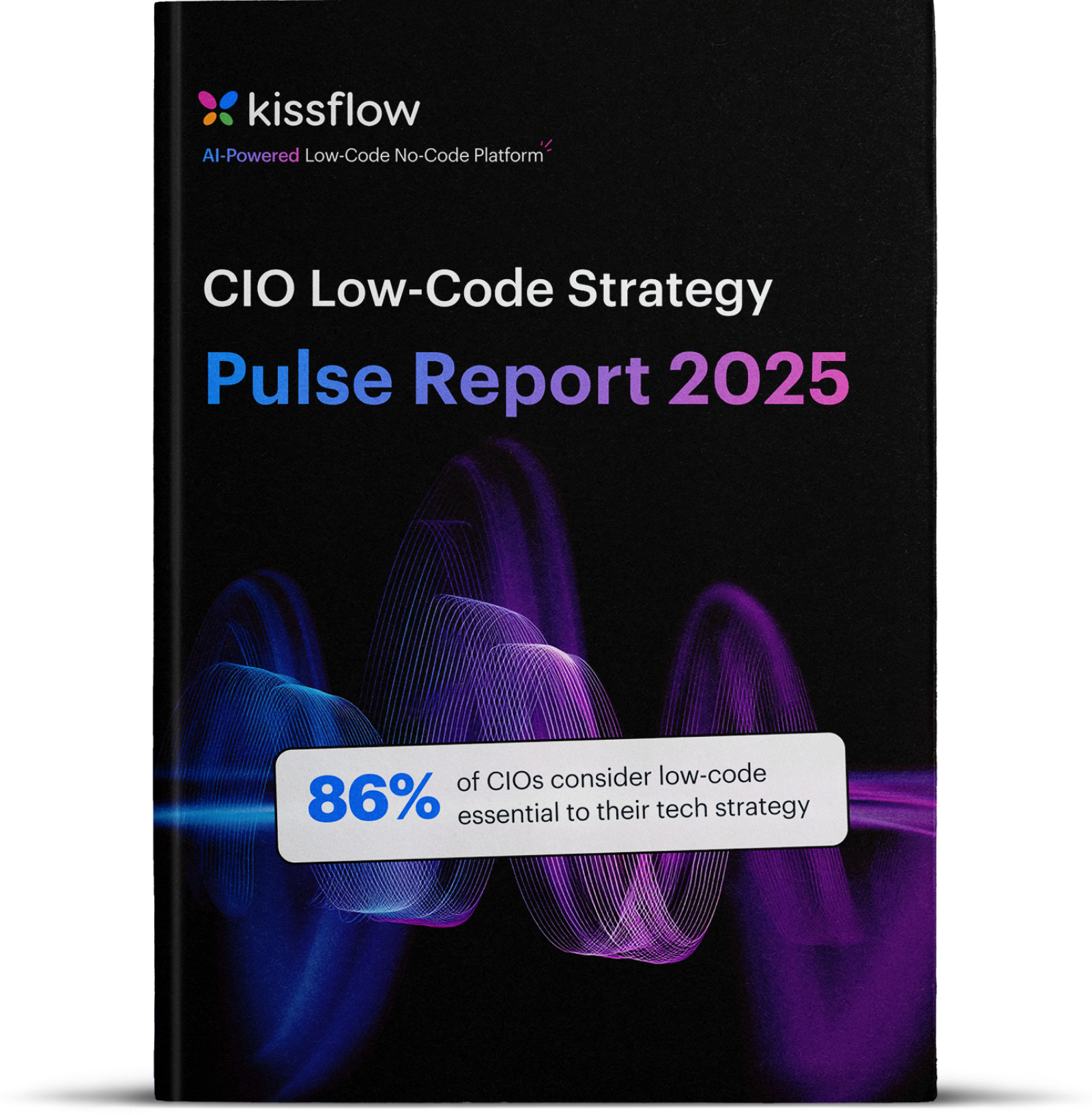AI-driven workflows require faster deployment cycles, legacy systems need immediate modernization, and the global developer shortage continues to deepen. The United States alone is projected to face a talent gap of 1.2 million developers by 2026, according to McKinsey. Their research also indicates that 87 percent of businesses are already experiencing or expecting critical technology skill shortages, putting direct pressure on IT teams.
Low-code platforms are emerging as the strategic answer. Gartner forecasts that 75 percent of all new enterprise applications will be built using low-code technologies by 2026, compared to less than 25 percent in 2020. The global low-code market has already reached 26.9 billion dollars in 2023 and is projected to grow to 44.5 billion dollars by 2026 at a 19 percent CAGR, based on data from Statista . Forrester reports that 87 percent of enterprise developers now use low-code tools, while McKinsey’s analysis shows that these platforms can reduce development time by up to 90 percent.
This shift is driven by more than faster development. As enterprises adopt AI agents, intelligent automation, and hyperautomation, low-code platforms have become the critical bridge between business needs and technical implementation. Gartner expects that by 2026, 80 percent of low-code users will operate outside formal IT departments, accelerating citizen development and distributed application building across the enterprise
In this guide, we compare and rank the best low-code tools and the best low-code platforms for 2026, evaluating them based on enterprise governance, scalability, AI capabilities, integration depth, pricing, and overall readiness for modern IT needs.
Quick Comparison of the Top Low-Code Tools in 2026
| Low-code platform |
Best for |
Key features |
| Kissflow |
Enterprise workflow automation, governed citizen development, scalable internal applications |
Visual app builder, workflow automation, form designer, integration hub, role-based governance, AI-powered workflows |
| OutSystems |
Large and complex enterprise-grade applications |
Full-stack development, microservices support, AI-assisted development, multi-channel apps, DevOps automation |
| Mendix |
Multi-cloud enterprise applications and rapid app delivery |
Low-code + pro-code fusion, cloud-native deployment, visual logic builder, collaboration tools, reusable components |
| Microsoft Power Apps |
Organizations fully within the Microsoft ecosystem |
Canvas and model-driven apps, Dataverse integration, 1000+ connectors, AI Builder, low-code automation via Power Automate |
| Pega |
End-to-end enterprise automation and case management |
Business rules engine, case management, AI decisioning, workflow orchestration, robotic automation |
| Zoho Creator |
Small and medium businesses needing quick apps |
Drag-and-drop builder, basic workflows, multi-device apps, simple integrations, reporting |
| ServiceNow |
Enterprise digital workflows and service operations apps |
Workflow automation, ServiceNow platform integrations, form builder, process optimization, enterprise data governance |
| Appian |
Enterprise process automation and case handling |
Workflow modeling, BPM capabilities, robotic process automation, rules engine, low-code app builder |
| Quickbase |
Mid-market operational workflows and team applications |
Form builder, automation engine, dashboards, collaboration tools, flexible data modeling |
| Appsmith |
Developer-oriented internal tools (open-source) |
UI widgets, API and database integrations, Git versioning, custom scripting, self-hosting options |
Detailed List of the 10 Best Low-Code Tools in 2026
1. Kissflow (Best for Enterprise Low-Code Governance)
Best For: Enterprise workflow automation, governed citizen development, and scalable internal applications
Overview:
Kissflow is a unified low-code platform designed for enterprise IT teams that need both agility and strict governance. It streamlines workflow automation, app development, and form creation in a single interface, making it easy for business users to build apps while IT maintains full visibility and control. Kissflow excels in handling workflow-heavy processes and empowering non-technical users safely through strong governance policies.
Key Features:
AI workflow builder, visual app designer, workflow automation, integration hub, role-based governance, reusable templates, external portals, form builder.
Strengths:
Excellent governance framework, very fast to build and deploy apps, highly intuitive for business users, strong workflow capabilities, ideal for citizen development programs, seamless IT oversight.
Ideal Use Cases:
Approval apps, procurement workflows, onboarding workflows, finance request apps, service requests, departmental apps, data collection apps.

2. OutSystems (Best for Large and Complex Enterprise Applications)
Best For: High-performance enterprise apps and large-scale digital transformation projects
Overview:
OutSystems is a powerful low-code platform built for enterprises that need full-stack capabilities. It combines low-code speed with pro-code extensibility, allowing teams to build mission-critical applications with complex logic, advanced UI, and deep integrations. OutSystems is ideal for organizations modernizing legacy systems or building sophisticated multi-channel apps.
Key Features:
Full-stack development, microservices, AI-assisted development, multi-channel UI, reusable components, CI/CD pipeline, cloud-native architecture.
Strengths:
Great for complex, custom applications; strong DevOps and deployment pipelines; highly scalable; advanced debugging and pro-code capabilities.
Limitations:
Steep learning curve, resource-intensive for smaller teams.
Ideal Use Cases:
Customer portals, enterprise-grade applications, modernization projects, high-load digital experiences.

3. Mendix (Best for Multi-Cloud Enterprise Applications)
Best For: Enterprises adopting cloud-native deployments and collaborative app development
Overview:
Mendix supports both low-code and pro-code development, making it ideal for mixed teams of business users and professional developers. With strong multi-cloud capabilities and an ecosystem of reusable components, Mendix is one of the most flexible platforms for organizations pursuing digital transformation at scale.
Key Features:
Visual logic builder, cloud-native deployment, reusable app components, AI-assisted development, multi-cloud support, strong collaboration tools.
Strengths:
Robust environment management, deep multi-cloud support, strong collaboration between business and IT.
Limitations:
More complex than typical low-code tools; requires training for non-technical users.
Ideal Use Cases:
Enterprise web apps, customer portals, mobile apps, modernization projects.

4. Microsoft Power Apps (Best for Microsoft-Focused Organizations)
Best For: Teams using Microsoft 365, Dynamics, Azure, and Dataverse
Overview:
Power Apps enables teams to build business apps rapidly using connectors across the Microsoft ecosystem. It is especially strong in automating internal workflows, integrating disparate data sources, and building departmental apps that leverage the larger Microsoft stack.
Key Features:
Canvas apps, model-driven apps, Dataverse, Power Automate flows, AI Builder, 1000+ connectors.
Strengths:
Exceptional integration with Microsoft products, large connector ecosystem, strong automation when paired with Power Automate.
Limitations:
Governance challenges at scale; performance limitations with complex apps or large datasets.
Ideal Use Cases:
Internal departmental apps, CRM extensions, field apps, data entry apps.

5. Pega (Best for AI-Driven Case Management and Enterprise Automation)
Best For: Case management, intelligent automation, and enterprise workflow orchestration
Overview:
Pega combines low-code application development with advanced case management and AI-driven decisioning. It is widely used in banking, insurance, and large enterprises that require strong workflow orchestration and business rules automation across complex processes.
Key Features:
Case management, AI decisioning, workflow orchestration, business rules engine, robotic automation.
Strengths:
Excellent for large-scale process automation; powerful rules and decision flows; strong AI-driven case handling.
Limitations:
Complex setup and configuration; not ideal for simple use cases.
Ideal Use Cases:
Claims processing, customer service workflows, financial services operations, regulated processes.

6. Zoho Creator (Best for Small and Mid-Sized Business Apps)
Best For: Quick app building for SMBs and non-technical teams
Overview:
Zoho Creator is designed for teams that need to build simple applications quickly without deep technical expertise. It offers a drag-and-drop interface, mobile app support, basic workflow automation, and integrations with the Zoho ecosystem.
Key Features:
Drag-and-drop builder, basic workflows, mobile apps, simple integrations, reporting.
Strengths:
Very easy to learn; fast app creation; affordable for small teams.
Limitations:
Limited enterprise-grade governance; not ideal for complex or mission-critical applications.
Ideal Use Cases:
Small business workflows, data collection apps, simple approval apps, inventory tracking.

7. ServiceNow App Engine (Best for Enterprise Digital Workflows)
Best For: Organizations managing service operations and enterprise-wide digital workflows
Overview:
ServiceNow App Engine allows enterprises to build applications on the ServiceNow platform, extending workflow capabilities across IT, HR, finance, and operations. It is ideal for organizations standardizing processes on ServiceNow and looking to automate at scale.
Key Features:
Workflow automation, form builder, enterprise governance, process optimization, ServiceNow integrations.
Strengths:
Strong enterprise governance; excellent for service operations; deep platform integration.
Limitations:
Best suited only if the organization already uses ServiceNow; limited flexibility outside the ecosystem.
Ideal Use Cases:
ITSM extensions, HR workflows, operations workflows, employee self-service apps.

8. Appian (Best for Enterprise Process Automation)
Best For: Enterprise process modeling, RPA, and workflow-driven applications
Overview:
Appian is a low-code platform focused on process automation and case management. It offers strong BPM capabilities combined with low-code app development, making it a popular choice for enterprises automating complex workflows.
Key Features:
Process modeling, workflow automation, case management, RPA, rules engine.
Strengths:
Strong BPM foundation; excellent case management; good for regulated industries.
Limitations:
UI customization is limited compared to modern low-code tools.
Ideal Use Cases:
Compliance workflows, financial workflows, service operations, case management.

9. Quickbase (Best for Operational Workflows and Team Apps)
Best For: Mid-market operational workflows and team applications
Overview:
Quickbase enables teams to build flexible operational apps without coding. It focuses on workflows, forms, dashboards, and collaboration features, making it ideal for operations-driven use cases.
Key Features:
Form builder, workflow engine, dashboards, roles and permissions, automation.
Strengths:
Easy to use; strong for repetitive operational tasks; good data modeling.
Limitations:
Limited for large-scale enterprise app builds.
Ideal Use Cases:
Project tracking, operations workflows, audits, resource management.
10. Appsmith (Best for Developer-Driven Internal Tools)
Best For: Developer teams building internal tools with full customization
Overview:
Appsmith is an open-source low-code platform designed for building internal tools with high flexibility. It allows developers to create custom UIs using widgets and connect them to databases and APIs with minimal friction.
Key Features:
UI widgets, API/database integrations, JavaScript customization, Git versioning, self-hosting.
Strengths:
Highly customizable; excellent for developer teams; open-source extensibility.
Limitations:
Not suitable for enterprise governance or workflow-heavy use cases.
Ideal Use Cases:
Internal dashboards, admin panels, data entry tools, internal CRUD apps.
Use Cases of Low-Code Tools
1. Workflow Automation Across Departments
Low-code enables IT and business teams to rapidly automate critical workflows including procurement approvals, onboarding processes, expense management, vendor reviews, and audit-ready workflows. These automations reduce manual effort, eliminate bottlenecks, and increase process visibility.
2. AI-Driven Intelligent Workflows
Platforms now combine low-code with AI models to recommend next steps, automate decisions, route tasks intelligently, and analyze data in real time. This is especially powerful in industries like BFSI, telecom, and retail, where high-volume decision-making is common.
3. Legacy System Modernization
Enterprises use low-code to replace aging systems, rebuild outdated applications, and extend legacy platforms with modern interfaces and automations. This reduces technical debt and accelerates digital transformation.
4. Internal Business Applications
Low-code accelerates the creation of internal tools such as inventory systems, IT ticketing apps, asset management apps, compliance trackers, and project dashboards. These apps can be built in days instead of months.
5. Customer and Partner Portals
Secure, role-based portals can be created to streamline onboarding, service requests, case submissions, vendor interactions, project collaboration, and customer support workflows.
6. Case Management Solutions
Industries like insurance, healthcare, BFSI, and logistics use low-code to build dynamic case management apps that adapt based on context, rules, and decision flows.
7. Data Collection and Form-Based Applications
Teams rapidly create multi-step forms, inspection apps, survey tools, audit checklists, and data intake applications without involving developers.
8. Automated Approvals and Request Management
Low-code simplifies request-driven workflows such as IT provisioning, HR requests, procurement approvals, budget approvals, and change management workflows.
9. Field Service and Mobile Apps
Mobile-first apps for field inspections, maintenance tracking, onsite issue reporting, attendance logging, and equipment checks can be built and deployed quickly.
10. Integration and API Automation
Low-code platforms allow enterprises to orchestrate data flows across systems including ERP, CRM, HRMS, and custom applications, enabling seamless integration and real-time automation without needing deep engineering expertise.
Different categories of low-code development tools
Low-code development tools can be grouped based on their core purpose, whether they are used for workflow automation, enterprise-grade app building, or integration within existing systems. Each platform offers unique strengths depending on the organization’s needs. Below are the main categories and examples of tools that fit into each, featuring Kissflow in every group.
1. General-purpose low-code platforms
These platforms allow businesses to create a wide range of applications, from internal tools to customer-facing apps, using visual builders, reusable components, and built-in integrations. They are ideal for teams seeking flexibility and scalability without heavy coding.
Examples:
-
Kissflow: Combines low-code functionality with a no-code interface, empowering both IT and non-technical users to build workflows, forms and enterprise applications with ease.
-
OutSystems: A robust platform with AI-assisted tools, reusable components, and multi-channel deployment options.
-
Mendix: Provides model-driven development for web and mobile applications, suitable for rapid enterprise app delivery.
-
Appian: Focuses on process-driven app creation with advanced automation and unified data integration.
2. Workflow automation platforms
These tools simplify and automate repetitive processes like approvals, onboarding, and document routing. They use drag-and-drop builders and visual logic to help businesses design and execute workflows quickly.
Examples:
-
Kissflow: Offers an intuitive workflow builder that enables teams to automate complex processes and connect them with existing systems.
-
Pega: Uses AI-powered decision-making to automate workflows and improve operational efficiency.
-
Appian: Combines workflow automation with robotic process automation (RPA) for complete process management.
-
ServiceNow: Known for its IT service management automation that extends to enterprise-wide workflows.
3. Enterprise application development platforms
These platforms cater to large organizations that need scalability, governance, and advanced integration capabilities. They are best suited for building mission-critical applications that span multiple departments or customer-facing systems.
Examples:
-
Kissflow: Serves as an enterprise-ready platform that connects business and IT teams, enabling faster application deployment with proper governance.
-
OutSystems: Recognized for enterprise-grade development with lifecycle management, DevOps integration, and strong security features.
-
ServiceNow: Originally built for IT service management, it now supports enterprise app development with extensive process control.
-
Appian: Offers a unified design environment for enterprise automation and digital transformation projects.
4. Business process management (BPM) platforms
These platforms combine low-code development with process modeling and analytics to help organizations design, monitor, and optimize end-to-end business processes.
Examples:
-
Kissflow: Integrates low-code app building with BPM features, allowing users to manage workflows and measure process performance effectively.
-
Pega: Known for its BPM engine and AI-driven insights that help improve customer engagement and operational outcomes.
-
Appian: Offers a process-first architecture that simplifies the design and management of digital processes.
-
Mendix: Supports process-centric application development with model-driven workflows and process optimization tools.
5. Citizen development platforms
These platforms are designed for non-technical users who want to create applications and automate processes on their own without depending heavily on IT support.
Examples:
-
Kissflow: Built specifically to empower citizen developers with easy-to-use tools for app creation and process automation.
-
Microsoft Power Apps: Ideal for Microsoft 365 users who want to build applications connected to Office, Teams, and Dynamics data.
-
Zoho Creator: Enables small teams to create customized applications and integrate them with the Zoho ecosystem.
-
Mendix: Provides a collaborative workspace where both business users and developers can co-create applications efficiently.
Why Kissflow low-code is the best low-code development for your enterprise business
A modular, scalable solution
Kissflow low-code’s idea is to combine the simplicity of no-code with the power of low-code. Having said that, of course, that implies the fact that Kissflow Low-Code can work in conjunction with the range of scalable tools used by your enterprise covering ticketing systems, payment apps, CRM, and support desk, among others. Kissflow Low-Code is modular so the platform can grow alongside your business as you scale and face the need for more advanced features across different custom apps that your teams create, making it a truly customizable and scalable app development platform designed to bolster productivity.
Easy to use
In addition to Kissflow Low-Code’s modularity, the platform itself is intuitive. Many low-code platforms struggle to find the balance between connecting processes and systems with people, and ease of use. The good news is that Kissflow Low-Code doesn’t sacrifice ease of use for the sake of power, which is particularly important for anyone who is not incredibly good at coding. The drag and drop feature enables any kind of user irrespective of their coding knowledge to kickstart custom app development at their disposal.
Easy to build
Kissflow Low-Code is not only easy for end-users to navigate and use daily, but is also incredibly easy to create with. For example, custom app or workflow building areas like employee onboarding apps, leave request forms, and asset tracking workflows, are all drag and drop. You can also bulk-build, test, and deploy them all under one roof. This will come as a huge advantage for many tech and non-tech teams who simply don’t have time for multiple iterations.
Questions to ask before choosing the best low-code development tool
-
What kind of apps will your teams be building?
-
What type of pricing does the vendor follow?
-
How do you handle security?
-
Can you customize the apps or include custom business logic?
-
What’s the skill set required by employees of your company to use the platform?
-
How easy is the integration with your existing systems?
-
Does the vendor have expertise in helping with bringing the solution to the market?
-
What is the most complex application built on this platform?
Conclusion
Although there has been an explosion in the number of leading low-code development platforms recently, that doesn’t mean the low-code market is becoming saturated. Competition is ensuring that all of these low code vendors are fighting to provide the most for your money. A good place to start your search is with Kissflow Low Code. It’s got a powerful form builder and an easy-to-use visual editor which enables you to create your own apps, without needing to code. No matter which industry or audience you cater to.
FAQ's - Best low code platforms
1. How do low-code automation platforms accelerate digital transformation?
Low-code automation platforms accelerate digital transformation by enabling faster app development, simplifying process automation, and reducing IT backlogs. They empower both professional developers and citizen developers to build and deploy business applications quickly using visual tools, helping organizations innovate faster while maintaining governance and scalability.
2. What makes a low-code platform enterprise-ready?
An enterprise-ready low-code platform offers scalability, robust security, governance controls, and integration with existing enterprise systems such as ERP and CRM. It supports role-based access, compliance with standards like GDPR and SOC 2, and can handle mission-critical workloads with high performance and reliability.
3. Can low-code platforms handle complex workflows and integrations?
Yes, modern low-code platforms are designed to manage complex business processes through workflow automation, conditional logic, and seamless API integrations. They easily connect with third-party systems like Salesforce, SAP, and Microsoft 365 to ensure smooth data exchange and end-to-end automation across departments.
4. How are AI and machine learning being integrated into low-code platforms?
AI and machine learning are increasingly embedded in low-code platforms to enhance automation and decision-making. These capabilities help auto-generate workflows, predict process outcomes, detect anomalies, and recommend optimizations, making app development more intelligent and efficient.
5. How does a low-code platform improve collaboration between IT and business teams?
Low-code platforms create a shared workspace where IT and business users can work together on application design and deployment. Features like drag-and-drop builders, commenting systems, and version control enable real-time collaboration, faster feedback loops, and better alignment between business requirements and technical execution.
6. Why is Kissflow considered one of the leading low-code automation platforms in 2026?
Kissflow stands out for its unified platform that combines no-code and low-code capabilities, allowing both citizen developers and IT professionals to collaborate effectively. It offers AI-powered workflow automation, strong governance, scalability, and integration support, making it one of the most comprehensive enterprise-grade low-code platforms available in 2026.





















